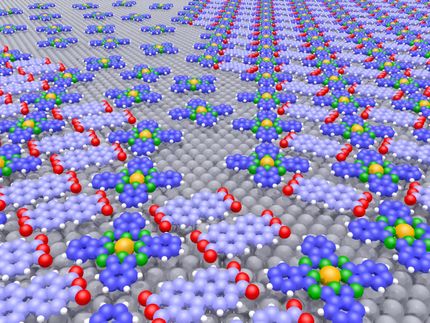Penn engineers show how 'perfect' materials begin to fail
Crystalline materials have atoms that are neatly lined up in a repeating pattern. When they break, that failure tends to start at a defect, or a place where the pattern is disrupted. But how do defect-free materials break?
Until recently, the question was purely theoretical; making a defect-free material was impossible. Now that nanotechnological advances have made such materials a reality, however, researchers at the University of Pennsylvania and Germany's Max Planck Institute for Intelligent Systems have shown how these defects first form on the road to failure.
In a new study, published in Nature Materials, they stretched defect-free palladium nanowires, each a thousand times thinner than a human hair, under tightly controlled conditions. Contrary to conventional wisdom, they found that the stretching force at which these wires failed was unpredictable, occurring in a range of values that were more strongly influenced by the ambient temperature than was previously believed.
This thermal uncertainty in the failure limit suggests that the point where a failure-inducing defect first appears is on the nanowire's surface, where atoms behave in a more liquid-like way. Their increased mobility makes it more likely they will rearrange themselves into the beginnings of a "line defect," which cuts across the nanowire, causing it to break.
The study was led by graduate student Lisa Chen and associate professor Daniel Gianola of the Department of Materials Science and Engineering in Penn's School of Engineering and Applied Science. Other members of Gianola's lab, postdoctoral researcher Mo-Rigen He and graduate student Jungho Shin, contributed to the study. They collaborated with Gunther Richter of the Max Planck Institute for Intelligent Systems.
"Nanotechnology is not just about making things smaller," Chen said, "it's also about different properties that arise in materials at the nanoscale."
"When you make these really small structures," Gianola said, "they're often grown from the bottom up, in an atom-by-atom, layer-by-layer process, and that can give you a much more pristine structure than if you were to take a big block of metal and whittle it down. In addition, the atoms on the surface comprise a much larger proportion of the total and can control the properties of the nanoscale material."
The researchers grew palladium nanowires through a vapor deposition method at high temperature, which provided each atom with the time and energy to move around until it found its preferred spot in the metal's crystalline structure.
Sprouting from a substrate like blades of grass, the team used a microscopic robotic manipulator to painstakingly pluck the wires and attach them to their testing platform inside an electron microscope.
This platform, developed in conjunction with Sandia National Laboratory, functions like an industrial mechanical testing machine at the nanoscale. Welding a nanowire to a grip attached to a series of slanted bars that expand when heated by an electric current, the researchers could then stretch the nanowire in a controlled way. By repeatedly ramping up the voltage to a different maximum and bringing it down at the same rate, the researchers could pinpoint when the first irreversible deformation in the wire occurred.
"Just pulling it until it fails doesn't tell you exactly where and how that failure began," Gianola said. "Our goal was to deduce the point where the first of the nanowire's atoms begin to shift out of their original positions and form a mobile defect."
Computational studies suggested this point could be revealed by studying the temperature dependence of failure. Absent defect-free nanowires to run physical experiments upon, earlier theories and analyses suggested that the relationship between temperature and strength was deterministic; knowing the temperature would allow one to estimate a nanowire's failure limit.
By conducting their stretching experiments at various temperatures, the researchers were able to chart these failure points. Surprisingly, they found the wires' strengths scattered over a range of values, even when stretched at the same temperature.
"We've been able to verify," Chen said, "through experiment, and not just theory, that this process is thermally activated, and that there's a large randomness to the process. Normally you can say a bulk material has certain strength at a certain temperature, but you have to take a different approach to specify the strength of the nanowire. Depending on the temperature you're concerned with, even the distribution of strengths can vary drastically."
That this distribution occurred over a relatively large range of values meant that the thermal activation barrier, the amount of energy necessary to jump-start the nucleation of the first defect, was relatively low. Comparing the size of this thermal activation barrier to other atomistic mechanisms gave the researchers some insight into what was driving this process.
"Diffusion of atoms on a surface," Gianola said, "is the only mechanism that has this low thermal activation barrier. Surface diffusion is atoms hopping around, site to site, somewhat chaotically, almost like a fluid. A palladium atom sitting inside the bulk of the wire has 12 neighbors, and has to break most of those bonds to move around. But one on the surface might have only three or four to break."
Understanding the origin of the distribution of strengths in nanostructures will allow for more rational design of devices.
"Until recently," Gianola said, "it's been very difficult to make defect-free nanowires. But now that we can, there's a reason to care about how they fail. Their strengths are nearly a thousand times what you would get from the bulk material with defects -- in this experiment, we observed, to our knowledge, the highest strengths ever measured in that crystal structure of metal -- so they're going to be attractive to use in all sorts of devices."






























































